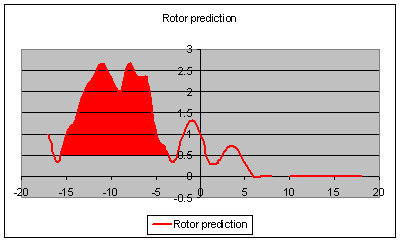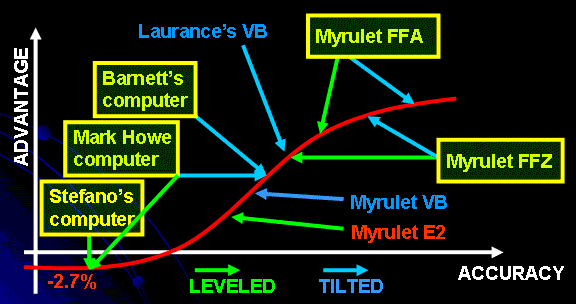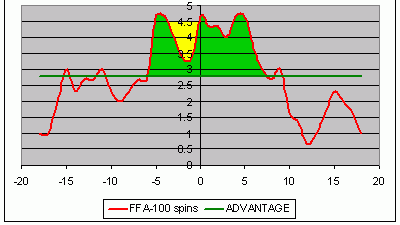The previous article was showing effects of FFA computer in the attempt to predict where the ball will hit the rotor. Results were simulated to explain what would be the outcome after 10,000 spins. On this graph is displayed the FFA’s real performance on the same wheel.
The FFA was set to get the best accuracy which means that the prediction was set to be later. Averaging to 6.8 seconds before then the ball drops.


After playing five spins (only) to let the system learn the wheel parameters, I decided to set the offset to +16 pockets. The graphs show exact final results where the ball was stopping after the predicted number. Everything marked with green colour is where the advantage is. After analysing data if someone was playing according to this prediction and covering 11 pockets from -5 to +5 from prediction, he would play with an advantage of 53%.
It is average of 4.24 hits per 100 spins for each pocket in the green area. It means that for playing $100 per spin on average, the player would profit $53 each turn. If he were playing a bit more to the right and covering six pockets, the advantage would be slightly better 58% because the area marked with yellow colour would be avoided. It is a typical problem when playing in the real environment. Sometimes players decide where to play is not the best or he wouldn’t be able to cover all numbers as he wants to.
53% and 58% are real advantage figures after the system overcome contrary 2.7% house advantage.
To achieve such advantage of course that we need an accurate prediction.
During the test, I took notes of only first 30 spins to see how well the system predicts ball failing point.
It is clear that the ball most of the time was hitting the rotor ten pockets in front of the predicted number or around that position. If there is no ball bouncing, such accurate prediction will produce 270% advantage. From this, we can understand how precise perdition of failing point needs to be that after scatter we still have a recognisable advantage. Computerized roulette prediction is no voodoo black magic, golden spiral or numbers found in nature as some are claiming. It is physics and nothing else.
Roulette computer which can’t predict ball failing point as the FF or at least close to it can’t predict anything.
If I set the system to predict earlier, due to previously explained problems 270% would gradually decrease which would result in a proportional decrease of player’s advantage.
By how much it would change, it is specific for every particular wheel. That is why the ability of FF systems to define accuracy is an essential feature, especially on some wheels. As a final word to this article, I will display my opinion progress of systems developments for advantage players.

The red line represents advantage increase in systems accuracy. Of course at the bottom is starting point of casinos 2.7% advantage. In the end, the curve is losing intensity. It is because after some points regardless how much accuracy increases we can’t increase advantage because of roulette laws explained in the previous article.
Because of the same reason, there is not much difference in between FFA and FFZ.
Blue arrows are representing system effective on the levelled roulette wheel, and green indicators are related to tilted wheel or the wheel with a dominant drop point.
As you can see right after FF systems is Laurance’s visual prediction for a tilted roulette wheel.
The question which may arise is why I play my VB if I placed his one at a higher place.
Well, his system may be more powerful, but it requires a lot of skill that needs to be practised. I understand his approach, and in communication with some that use it, I found it hard. It takes care of this and this and this etc.
Roulette visual prediction I play, on my computer, gives me wheel specification? After that, I do not need a computer. The system is easy to apply, but it doesn’t provide all of his methods could do.
I found my system efficient enough, and because it is simple to apply, I prefer to use it.
Also, I placed Laurence’s visual prediction in front of Michael Barnett and Mark Howe’s computer for tilted wheel because it can do more. They have a computer which only produces plain results on the tilted wheel as I was explaining in the previous article.
Therefore they can’t have a very high advantage. Laurence’s VB theoretically can achieve a better result. Assuming that someone experienced and skilful is using it, he can produce better advantage while on the other hand if the player is without the full understanding computer may be better.
I placed my VB2 program version on the computer because computers can better calculate rotor speed changes. I am still working to improve my skills for that.
E2 is unique and probably the only one kind of visual prediction capable of gaining an advantage on levelled roulette wheels. It uses a timer as a reference, and it needs a lot of practice.
Stefano’s and Mark’s roulette computers cannot gain any advantage on a levelled wheel. Reasons for that I explained in few articles, and there is a lot discussion at my roulette forum. Same applies to Stefano’s Genuine Winner System. It is simple; there is no advantage if we are placing bets before then a dealer spins if roulette wheel doesn’t have some biased pockets. For that to find out, we do not talk about 333 or 666 spins based on numbers found in nature as Stefano claims. We talk about collecting thousands of spins, and even then it is very questionable.
The best information regarding this approach you can get from Snowman who sometimes writes articles at Gamblers Glen forum or perhaps from Kelly.
If you come to this point to read this, congratulation, please consider joining us at Forum.

Recent Comments